Sony Xperia XZ3 Review
Sony Xperia XZ3 Review
A move in the right direction
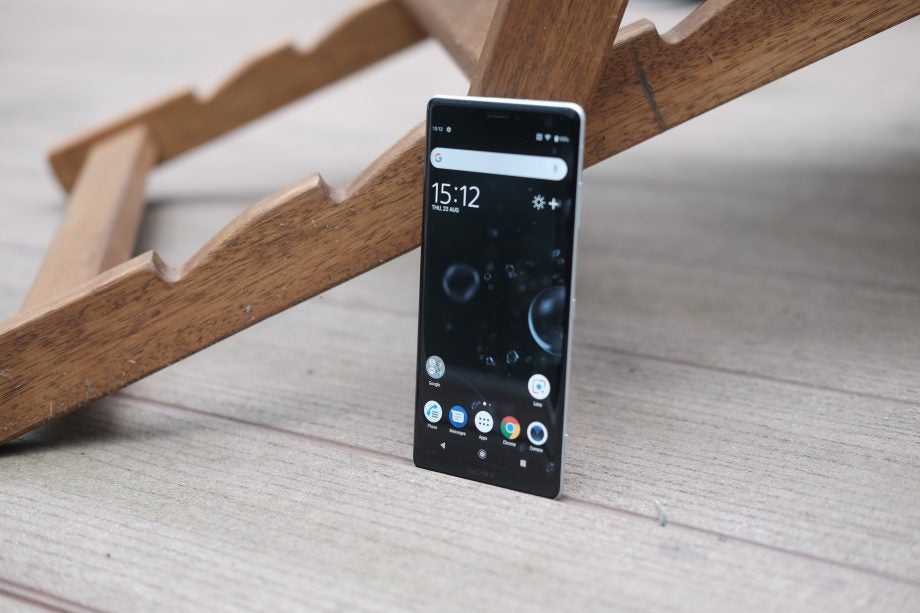
Verdict
A big step in the right direction for Sony flagships.
Pros
- Great OLED screen
- Good performance
- Decent battery life
- Comes with Android 9.0 Pie
Cons
- Pre-installed bloatware
- Camera can be a little slow
- Poor fingerprint scanner placement
- Side Sense is unreliable
Key Specifications
- Review Price: £699
- 6-inch OLED display
- Snapdragon 845
- 19-megapixel f/2.0 camera
- 3300 mAh battery
- Wireless charging
- Android 9 Pie
What is the Sony Xperia XZ3?
When it comes to its smartphones division, you couldn’t accuse Sony of resting on its laurels. Certainly, the company launches new phones more often than some people have hot dinners. The Xperia XZ3 follows hot on the heels of the Sony Xperia XZ2 and was then followed by the Sony Xperia 1.
Like the Xperia XZ2, the Sony Xperia XZ3 shows that the brand has truly moved on in terms of design. Thanks to a gorgeous new OLED display, a more modern design and top specifications, Sony finally feels like it has a fitting flagship. It isn’t quite ready to usurp its rivals but it’s a big step in the right direction – even if, ultimately, it isn’t that exciting.
Related: Sony Xperia 1 review
Sony Xperia XZ3 – Design
Until earlier in 2018, Sony had been clinging onto its OmniBalance design language – with its acute angles and sharp edges – for approaching half a decade. That’s practically a lifetime when it comes to tech. Just compare an iPhone 5 to anything you see today and you get an impression of how quickly tastes change.
Thankfully, it appears that Sony is finally ready to move on. The Sony Xperia XZ3 feels like a much more modern phone, although it still isn’t quite up to date. Its design has strong parallels with last year’s Google Pixel 2 and the Samsung Galaxy S8.
Related: Best smartphones
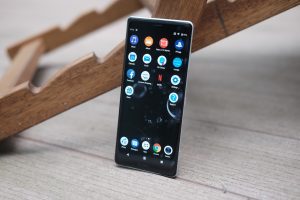
I mention the Galaxy S8, and not the newer Galaxy S9, because the S9 has reduced those top and bottom bezels. Placed next to smartphones such as the OnePlus 6, it’s in this regard that the Xperia XZ3 can still look a little dated.
Slightly thick top and bottom bezels aside, the much higher screen-to-body ratio does help make the XZ3 feel like a more modern phone. It remains svelte, which is a huge positive considering the unwieldy heft of the Sony Xperia XZ2 Premium.
This is a handset that’s covered in Gorilla Glass 5, both front and back, and held together with a tough aluminium rim. It feels well made, but all that glass does make it a little slippery in the hand.
Flip the phone around and one of my biggest grievances becomes apparent. The fingerprint scanner is awkwardly placed, smack in the centre of the rear.
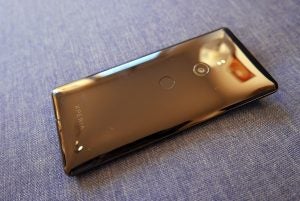
Grabbing the phone for the first time, it’s likely that the majority of people will find they naturally assume the camera is, in fact, the fingerprint scanner. With the scanner so low down, you have to hold the phone lower, which is awkward
The scanner is level with the power button on the right, which I’ll also argue is also placed in an unnatural position.
All of the phone’s buttons sit along the right edge, which leaves it feeling a little busy and unbalanced. The top half houses a volume rocker, the aforementioned power button sits in the middle, then towards the bottom, there’s a dedicated shutter button for the camera.
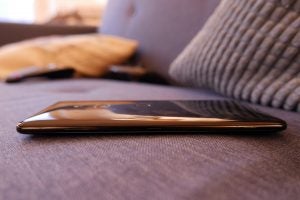
The shutter button can be half-pressed for focusing as it is on a fully fledged camera, and adds good tactility for snaps. However, I wish the button hadn’t been physically identical to the power button.
Like the XZ2 Premium, the headphone jack has been omitted, but you do get a USB-C to 3.5mm adapter included in the box. The XZ3 supports LDAC over Bluetooth for better quality, so audiophiles might not be quite as perturbed if they have compatible headphones (most models are from Sony).
Sony has bundled in its Dynamic Vibration System again here, and I actually quite like it. It’s definitely gimmicky, but also kind of fun. It ramps up the haptic vibration in line with the audio you have playing for some extra sensory feedback.
Actually, it’s a shame the feature only works with the screen on. I can imagine it would be battery-wasting fun to have it in your pocket while you listen to music, almost like the trance vibrator packs for anyone who remembers the video game Rez. If you’re going to do something as gimmicky as this, Sony, you may as well go all in.
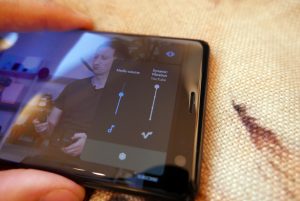
The screen is flanked by stereo speakers integrated into the bezel, and these produce a decent amount of volume. A little bit of Dynamic Vibration does actually help round out the low-end when watching films. Fortunately, you can choose the level of Dynamic Vibration you want; add in too much and you’ll probably find it a distraction.
Sony Xperia XZ3 – Display
The display in the Sony Xperia XZ3 has come on leaps and bounds from previous Sony flagships, due in no small part to the move from LCD to OLED technology. The 6-inch, QHD+ (1440 x 2880) OLED panel is fantastic to look at. The blacks are as deep as you’d expect and colours are much richer than previous Sony efforts.
Sony has supposedly used the same X Reality Pro engine from its Bravia line of TVs, and its efforts have paid off. The display supports HDR, so compatible content looks great. Brightness levels are great, too, so the screen is easy to see outdoors, and offers decent viewing angles overall.
There’s an ambient display mode that can show notifications and the time permanently, when you pick up the phone, or when you double-tap the screen. There’s also a nifty photo playback mode for the ambient display that shows off some of your photos.
The edge of the display now curves around the sides slightly. Sony makes use of this with ‘Side Sense’; double-tap the side of the screen to bring up a menu with shortcuts to apps, settings and notifications.
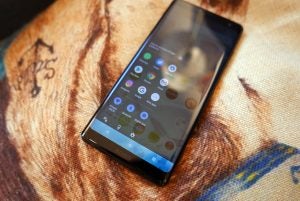
It’s a feature I could see myself using. However, getting it to work proved frustrating, requiring me to hold the device in a very specific way. I’m not sure that it can handle multiple parts of your hand touching the screen at the same time, which is practically impossible to avoid.
It’s a shame because it’s difficult to reach the notification shade on such a large phone one-handed. On other phones – Huawei or OnePlus models, for example – I’ve become used to a swipe down on the rear fingerprint sensor, but that isn’t an option here. Instead, there’s a notification shortcut buried in the Side Sense menu.
You’re also able to swipe down the edge of the display as a ‘Back’ shortcut, but I kept triggering this by accident. I ended up having to disable Side Sense altogether after a week of attempting to get to grips with it.
Sony Xperia XZ3 – Performance
| Screen | 6-inch, QHD+ OLED w/ HDR |
| Performance | Snapdragon 845 |
| RAM | 4GB |
| Storage | 64GB + microSD |
| Rear camera | 19MP, f/2.0 with 4K HDR recording |
| Front camera | 13MP, f/1.9 |
| Battery | 3300mAh, fast charge, wireless charging |
| Software | Android 9 Pie |
When it comes to specifications for a flagship smartphone in 2018, the XZ3 checks pretty much all the boxes. The Qualcomm Snapdragon 845 is the same system-on-chip seen in handsets from the OnePlus 6, Samsung Galaxy S9 (dependent on territory), LG G7, and Sony’s earlier 2018 Xperia XZ2. It’s still a plenty powerful chip.
Perhaps the only shortcoming is the 4GB of RAM, which pales against the OnePlus 6 – but then the Galaxy S9 similarly makes do with 4GB. It isn’t something that will impact day-to-day performance. The standard 64GB of storage is expandable through microSD too, which is welcome.
From the below comparison table, you can see the Xperia XZ3 acquits itself well against its rivals:
| Single-Core | Multi-Core | AnTuTu 7 | |
| OnePlus 6 | 2124 | 9045 | 267,001 |
| Huawei P20 Pro | 1921 | 6837 | 209,658 |
| Huawei Mate 10 Pro | 1906 | 6740 | 178,091 |
| Galaxy S9 Plus | 3720 | 8890 | 251,205 |
| iPhone X | 4257 | 10,364 | 235,607 |
| Pixel 2 | 1917 | 6312 | 184,336 |
| Xperia XZ3 | 3447 | 7669 | 255,187 |
I didn’t encounter any stutters hopping between apps. Oddly, the only minor hiccup involved bringing up the keyboard when tapping on a text field in certain apps such as WhatsApp. There’s a momentary stutter, which might well just be a bug.
Similarly, games run without a hitch. Frame rates in PUBG and Asphalt 9 were silky smooth.
Sony Xperia XZ3 – Software
The Xperia XZ3 comes with Android 9 Pie out of the box, which is a step up from the Xperia XZ2. However, some of the Android updates seen in Pie for other phones – such as Google’s Pixel 2 – are absent. For example, there’s no sign of the new gesture controls.
The continued frustration of pre-installed apps remains with inclusions like Booking.com, Kobo, AVG anti-virus and Amazon apps. In addition to these are Sony’s suite of apps, most of which you probably won’t care for. There are gimmicky options such as AR Effect and 3D Creator, and Xperia Lounge – whose purpose appears to be simply to serve you Sony-related adverts. Note, too, that it may not be possible to uninstall some of these apps; you might only be able to disable them.
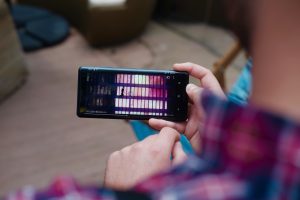
It’s not all bad news on the software front, however. Sony has added handy features such as a Glove mode option, which will be handy for prodding away at the touchscreen when the weather turns colder.
Then there’s the Photo Playback option for the ambient display. This can pull in photos from your camera roll to show when the phone is in standby; these can be geolocated so you get photos taken from your current location. At home, this meant being greeted by photos of our cats; in the office, it meant seeing the face of Trusted’s mobiles editor, Max Parker, and photos of my lunch.
And of course, there’s the aforementioned Side Sense – which, unfortunately, doesn’t work very well.
Sony Xperia XZ3 – Camera
While the Xperia XZ2 Premium introduced a dual-camera setup, it’s back to just a solo snapper for the XZ3, which is a tad disappointing. It has a 19-megapixel sensor paired with a f/2.0 aperture lens. The Xperia XZ2 Premium not only has two lenses, but both have larger apertures than the single option here.
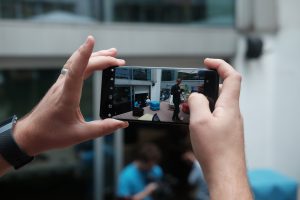
In general, the Xperia XZ3’s camera is fine – but it never particularly impresses. It has a habit of adding too much contrast to photos, making them look unrealistic and overly processed. Under trickier lighting conditions – when the sun is relatively low in the sky, for example – it has a tendency to over-expose shots, too. Low-light performance isn’t bad, although not as strong as the likes of the Google Pixel 2 or Samsung Galaxy S9.
Also included is a faux-bokeh mode, where the camera uses software to try to simulate a shallow depth of field, but it can get things quite wrong. That’s where a second camera sensor would have been useful for calculating depth. The camera app can also be a tad slow, and the auto-focus can hunt and struggle to get a lock as fast as I’d like.
Otherwise, the Xperia XZ3 delivers generally acceptable photos the majority of the time. They’re just nothing special.

Some low-light shots can end up looking a little washed out.

The camera can capture decent levels of detail.

Colours are generally rich.

Some trickier scenes can end up overexposed.

Low-light shots retain good detail with acceptable noise.

There’s a predictive capture mode, where you can pick the best shot from a batch.

Some shadow detail can get lost.
Sony has also added some automatic gesture recognition into the camera app. Raise the phone up, as if you’re about to take a photo, and it will automatically offer up the option of the camera app. It works semi-reliably, but, more often than not, I found myself resorting to the shutter button to launch the camera.
The XZ3 can shoot 4K HDR video, and it can also now manage 960fps super slow-motion video at 1080p.
Sony Xperia XZ3 – Battery life
The 3300mAh battery isn’t the biggest unit but paired with the more power-efficient OLED panel and the Xperia XZ3’s stamina, it’s pretty respectable. With standard use – which for me included lots of social media, some Spotify streaming, and listening to podcasts – I could take the phone off charge in the morning at 7:30am and still have around 20% remaining by 10pm.
I experimented with having the ambient display mode turned on permanently, with photo playback enabled. I found that under generally the same conditions, I’d end up with around 15% battery by 10pm.
Watch HDR content on Netflix at around half brightness and you’ll see a drop of around 10-12% an hour, which isn’t too bad.
The good news is that the Xperia XZ3 supports Qualcomm Quick Charge 3.0 for fast charging, and that glass back panel also means that Qi wireless charging capability is included, too.
Why buy the Sony Xperia XZ3?
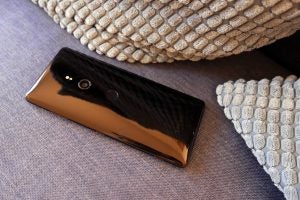
Ultimately, the Sony Xperia XZ3 is a competent flagship phone. It’s just a little difficult to feel particularly excited by it.
It certainly gets plenty right, helping to bring Sony in line with its rivals. Plus, the move to OLED is a positive one.
However, the device feels dated already. Ultimately, the Xperia XZ3 does little to really stand out from the crowd. On one side you have the likes of the OnePlus 6, which delivers similar performance and an arguably more attractive design for less. On the other is the Huawei P20/P20 Pro and Samsung Galaxy S9, phones that innovate more around their cameras.
Verdict
A big step in the right direction for Sony flagships.
How we test phones
We test every mobile phone we review thoroughly. We use industry standard tests to compare features properly and we use the phone as our main device over the review period. We’ll always tell you what we find and we never, ever, accept money to review a product.


